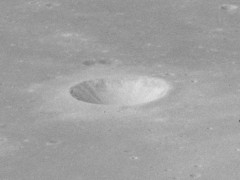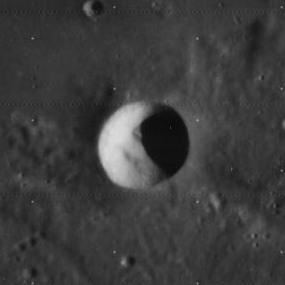
Bancroft is a small, bowl-shaped impact crater located to the southwest of Archimedes on the Mare Imbrium. A wide, shallow depression runs from the rim of Bancroft southeast to the Montes Archimedes. There are some clefts at the edge of the mare to the west and southwest of the crater. Other prominent craters are two small craters nearly to the west named Feuillée and Beer.

Beaumont is a lava-flooded crater located on the southwestern shore of the Mare Nectaris on Earth's Moon. It lies to the northwest of the similarly flooded crater remnant Fracastorius. To the west is the prominent crater Catharina. The crater is named after French geologist Léonce Élie de Beaumont.

Fracastorius is the lava-flooded remnant of an ancient lunar impact crater located at the southern edge of Mare Nectaris. To the northwest of this formation lies the crater Beaumont, while to the northeast is Rosse.

Aryabhata, named after Indian astronomer Aryabhata, is the remnant of a lunar impact crater located in the eastern Mare Tranquillitatis. The crater has been almost submerged by lava-flow, and now only an arc-shaped ridge formed from the eastern half of the rim remains above the lunar mare. This crater was previously identified as Maskelyne E before being named by the IAU in 1979. Maskelyne itself is to the southwest.

Ching-Te is a small lunar impact crater located in a mountainous area to the east of the Mare Serenitatis. It is a circular, bowl-shaped formation with no distinguishing features.
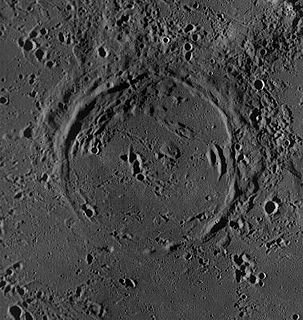
Daguerre is a circular formation near the north end of Mare Nectaris. To the west-northwest is the crater Mädler, and beyond it to the west is the prominent Theophilus. To the north in the rugged continental area between the maria is Isidorus.

Egede is the remains of a lunar impact crater that has been flooded by lava, leaving only the somewhat polygonal circumference of the rim protruding just above the mare. It was named after Dano-Norwegian natural historian Hans Egede. It is located on the southern edge of the Mare Frigoris, to the west of the crater Aristoteles. To the southwest is an arc of low mountains curving between the rims of Aristoteles and Eudoxus. The floor of Egede is flat and nearly featureless, except for a few tiny craterlets, including secondaries from Aristoteles. The surviving rim has a maximum altitude of 0.4 km above the surface.

Euler is a lunar impact crater located in the southern half of the Mare Imbrium, and is named after the Swiss mathematician, physician and astronomer Leonhard Euler. The most notable nearby feature is Mons Vinogradov to the west-southwest. There is a cluster of low ridges to the southwest, and this formation includes the small crater Natasha and the tiny Jehan. About 200 kilometers to the east-northeast is the comparably sized crater Lambert.

Polybius is a lunar impact crater in the southeast part of the Moon, and is named after ancient Greek historian Polybius. It is located to the south-southeast of the larger crater Catharina, in the area framed by the Rupes Altai scarp. Some distance to the northeast is the Mare Nectaris, with the flooded craters Beaumont and Fracastorius.
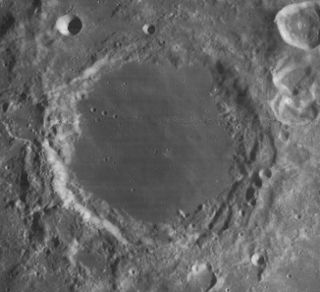
Endymion is a lunar impact crater that lies near the northeast limb of the Moon. It is located to the east of Mare Frigoris, and north of the Lacus Temporis. To the southwest is the somewhat smaller crater Atlas. Because of its location, Endymion has an oval appearance from foreshortening. Beyond the crater along the lunar limb is the Mare Humboldtianum.
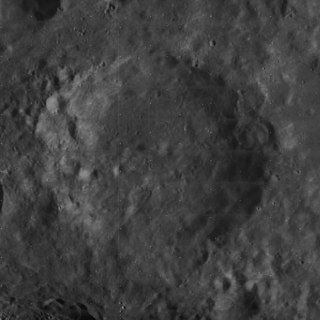
Snellius is a lunar impact crater located near the southeast limb of the Moon.
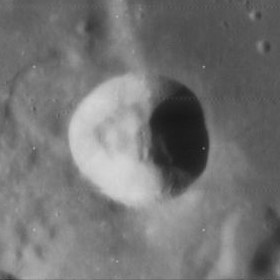
Bellot is a small lunar impact crater that is located on the southwest edge of Mare Fecunditatis. It lies between the craters Goclenius to the northwest and Crozier to the southeast. To the southwest is Colombo, and to the west is Magelhaens.

Bouguer is a lunar impact crater that lies along the southern edge of the Mare Frigoris, to the north of the crater Bianchini. To the west-southwest of Bouguer, along the same shore of the mare, is the crater Foucault. Nearly due west is the more prominent Harpalus, and to the west is La Condamine.

Blackett is a lunar impact crater that lies on the far side of the Moon, behind the southwest limb. It lies beyond the southeast outer ring of the immense Mare Orientale basin. The formation of that major feature has left Blackett deeply marked with ridge features trending from the northwest. Much of the crater has been shaped by the ejecta from Mare Orientale, particularly along the western half of the crater.

Black is a small lunar impact crater that lies just to the southeast of the walled basin Kästner. To the south-southwest is the crater Ansgarius, and to the east is the small Dale. It is located near the eastern limb of the Moon, just to the southwest of the Mare Smythii.
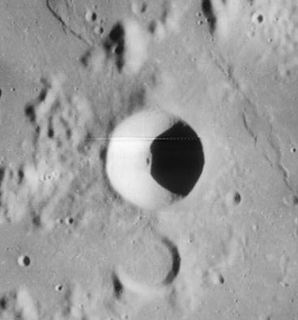
Darney is a small lunar impact crater that is located on the region of the Moon where the Mare Nubium joins the Oceanus Procellarum. It was named after French astronomer Maurice Darney. To the south is the lava-flooded crater Lubiniezky. The southern rim of Darney is attached to a series of low ridges that extend to the southwest.

Crozier is a lunar impact crater that is located on the southwest edge of Mare Fecunditatis, a lunar mare in the eastern part of the Moon's near side. It lies to the east-northeast of the prominent crater Colombo, and southeast of the small crater Bellot.

Eckert is a tiny, isolated lunar impact crater in the northern part of the Mare Crisium. This crater forms a circular pit in the dark surface of the surrounding lunar mare. Just to the west is a wrinkle ridge in the mare surface, a feature that is prominent only under oblique lighting from the Sun. The nearest craters of note are Peirce to the west-northwest, and Picard to the southwest. Both of these craters lie in the Mare Crisium basin.

Daubrée is a lunar impact crater that is located to the southwest of the Mare Serenitatis, just to the west-southwest of the crater Menelaus in the Montes Haemus range. The small lunar mare Lacus Hiemalis lies along the southwest rim of Daubrée. The crater was named after French geologist Gabriel A. Daubrée. It was previously designated Menelaus S.

Chalonge is a lunar impact crater that is located on the far side of the Moon. It lies to the southwest of the larger crater Lewis, in the outer skirt of ejecta that surrounds the Mare Orientale impact basin. To the southeast are the Montes Cordillera, a ring of mountains that encircle the Mare Orientale formation.


